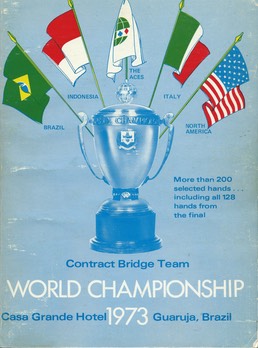
A couple of days ago, I posted a few hands from the 1973 world championships as a problem. Time to look at them and see what the experts did.
If you haven’t tried the problems, go back to the previous blog to try them yourself.
First you are east, with partner opening a 13-15 NT. Your options are 4♦ as a transfer to 4♠, 4♠ if you want to play that contract yourself, or 2♦ to start with a relay sequence. In the latter case, by the time it is over, partner has showed a maximum with 3♠-5♣-32 and the bidding is at 4♠. Your choice?
The hand does look attractive, but then take a closer look at what is needed in order to make a slam: a heart control, good clubs (♣KQJxx) to provide discards for all losers (♣KQxxx is not sufficient, as it requires the suit to split 3-3), and finally the ♠A. As, after a heart lead, you cannot afford to give up the ♠A as you still have heart losers, and 4 rounds of clubs in order to discard 2 hearts is not going to work either. So, while partner may have the perfect hand (♠Axx,♥Ax, ♦xxx, ♣KQJxx) I think it is too far fetched to play him for that and a simple 4♦ is sufficient. 4♠ has little merit, as there is no reason you should be playing the contract.

Belladonna agreed and bid 4♦, for +620, Hamman disagreed and leapt to 6♠ over 4♠. The actual layout is on the left. Forquet wasn’t impressed and simply cashed ♥AK followed by a ruff, for +13. This was a young Hamman, years later, as an older man, he said “don’t play me for the perfect hand, I don’t have it”.
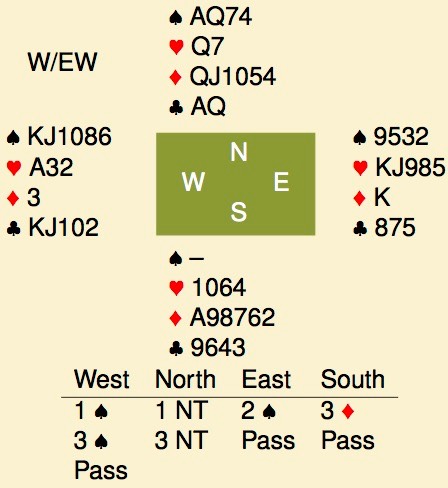
You are east, 1♠ shows 5 and is limited to 16 points, 1NT 15-18 balaned, 3♦ is competitive. Your lead?
At the table, the Italian east suspected that declarer was prepared for a spade lead and thus tried his second suit. ♥5 to the ♥A and bingo, down 1 before declarer had even started. Well judged by east.
In the replay, the action started the same up to 3♦ but then Forquet, North, decided to raise diamonds instead of trying NT again. That led to an unbeatable 5♦. +12 for Italy. I prefer Forquet’s diamond bid over 3NT at the other table. 3NT sounds too much of a matchpoint bid, while 5♦ is a good contract. On a spade lead, the ♦K can even be offside.
You’ve opened a 16+ 1♣, LHO overcalled 1♦ and you end up in 4♥, RHO passing through-out. ♠K lead to your ace, ♣K to west’s ace, ♣J to dummy’s queen. RHO showing an even number if you believe him. Now what?
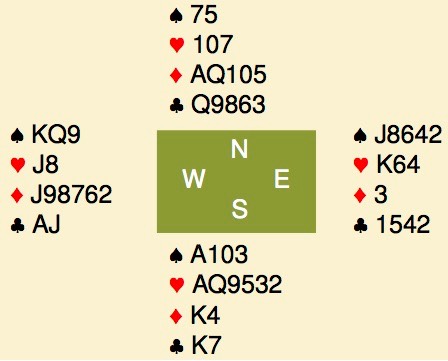
You will have to tackle trumps and, at first, playing to the ♥9 or to the ♥Q seems equivalent. However, you have some information about the hand: west has already shown ♠KQ and ♣AJ. That is 10 points out of 15 missing, so the odds move towards playing east for the ♥K and thus leading small to the ♥Q. The ♥-finesse worked and declarer followed with the ♥A, west dropping the ♥J.
All this did have one side effect: declarer could never score a ♠-ruff and had to rely on at least one discard on the diamonds. So ♦K, ♦4 to the ♦A. East ruffed with the ♥K and the defense cashed out for down 1. A 6-1 diamond split is not unlikely after this auction and I think this is a serious misjudgement by the North American declarer.
In the replay, the Italian west did better: he won the ♠K lead and returned the ♠3. Now declarer can always score a spade ruff. West won the ♠Q and returned a diamond to declarer’s king. Declarer ruffed a spade, played a heart to the Q and the ♥A. The defense got to score a trump, club and spade, for +12 imp’s to Italy.
2♦ showed a 3-suiter with short ♦, 2NT was a relay, 3♥ showed exactly 4-4-1♦-4 with 11-13. Your lead as south.
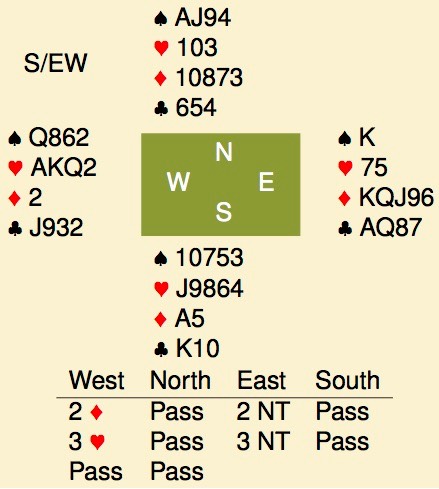
I never felt much for the Precision 2♦ (11-15, 3 suiter with a singleton ♦) opener, it seems like wasting an opening bid for a rare hand, but this time it worked out pretty nicely. South had a blind lead and, not unreasonably, led a heart. That hurt the defence and things didn’t get any better when declarer won the ♥A and returned the ♦2, ♦3, ♦K, ♦A. South had the same blind lead as before and decided to continue with the passive defense of a second heart. A spade switch would have defeated the contract. Or could have defeated, as north has to play east for a singleton ♠K. Odd-ball would have helped here, but that didn’t exist back then.
In the replay, EW bld clubs, diamonds and hearts before ending up in 3 NT as west. North led his best suit for down 1. 12 more Italian imp’s, this time mainly on system.
That is 48 imp’s to Italy. As I wrote yesterday, the score was an amazing 124-6 after 32 boards. The first Italian misjudgement and the first double digit swing to North American occurred on board 47.
1♠ spade was limited to 15, 4♣ a cuebid in support of clubs. Your lead as west.
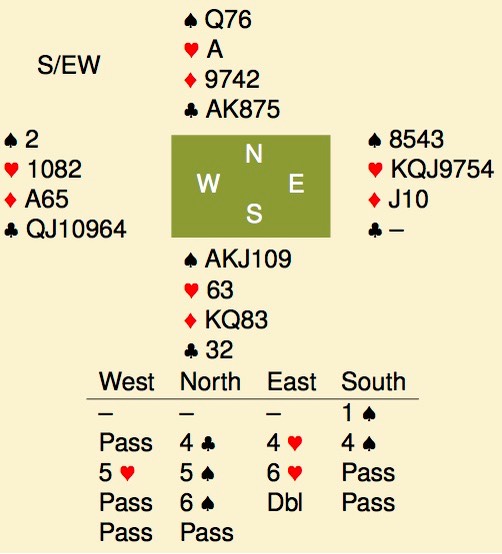
You expect this to be a Lightner double, with east holding a club void. But one trick is not sufficient to defeat a small slam, so you have to help partner a bit.
Lead the ♣4. Partner will ruff, then assume that this was a suit preference from your side and lead a diamond to your ace. A second club ruff ensures down 2 for 500.
I don’t quite understand south’s bidding on this one, it looks to me that he overbid a lot with his forcing pass over 6♥, inviting north to make another move. With all his offensive and little defensive strength, north had an obvious 6♠ bid. In the replay, the hand was quite boring, NS bid 4♠, making 10 tricks, for 15 imp’s.
